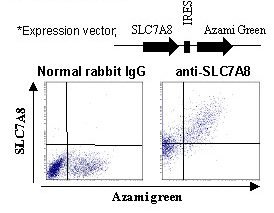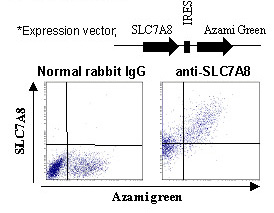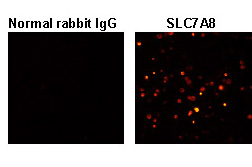Anti-SLC7A8 (LAT2) (Human) pAb
| Code | Size | Price |
|---|
| MBL-BMP041 | 50 ul | £323.00 |
Quantity:
Prices exclude any Taxes / VAT
Overview
Host Type: Rabbit
Antibody Isotype: IgG
Antibody Clonality: Polyclonal
Regulatory Status: RUO
Target Species: Human
Applications:
- Flow Cytometry
- Immunocytochemistry (ICC)
- Immunohistochemistry (IHC)
- Western Blot (WB)
Shipping:
4°C
Storage:
-20°C
Images
Documents
Further Information
Alternative Names:
LAT2
Applications:
WB - 1:1000 (chemiluminescence detection system) FCM - 1:200 ICC - 1:200 IHC - 1:1000 (Heat treatment required for paraffin)
Background:
SLC7A8, also called
L
-type amino
acid transporter 2 (LAT2), forms a heterodimeric complex
with the heavy chain of th
e cell surface antigen SLC3A2
(4F2hc/CD98). It transports neutral amino acids, most of
which are essential amino acids.
L
-Dopa, which is
commonly used to treat Parkinson?s disease, can enter the
brain as either the SLC7A8
(LAT2)/SLC3A2 complex or as
its homologue the SLC7A7 (LAT1)/SLC3A2 complex.
Furthermore, SLC7A8 is highly expressed in the epithelial
proximal tubule cells in the kidney; this suggests its role in
renal reabsorption of neutral amino acids.
Formulation:
50 ul volume of PBS containing50% glycerol, pH 7.2. No preservative is contained.
Gene IDs:
Human: 23428 Mouse: 50934
Immunogen Translated:
Synthetic peptide derived from human SLC7A8
Reactivity:
This antibody can be used to stain
endogenous antigen in paraffin embedded human tissues
including kidney and pancreas by Immunohistochemistry.
The reactivity has been confirmed by Western blotting,
Immunocytochemistry, and intr
acellular Flow cytometry to
detect the full length of human SLC7A8 transiently
expressed in HEK 293T cells.
Shelf Life:
1 year
Source:
This antibody was affinity purified from rabbit
serum. The rabbit was immunized with a synthetic peptide
derived from human SLC7A8.
Target:
SLC7A8
References
?1) Torrents, D., et al., Nature Genet. 21, 293-296 (1999)
2) Pineda, M., et al., J. Biol. Chem. 274, 19738-19744 (1999)
3) Torrents, D., et al., J. Biol. Chem. 273, 32437-32445 (1998)










